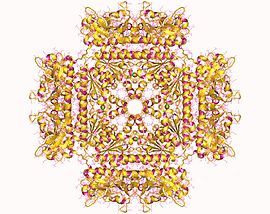Phosphoribosylaminoimidazolesuccinocarboxamide synthase
| SAICAR synthase | |||||||||
|---|---|---|---|---|---|---|---|---|---|

Phosphoribosylaminoimidazole succinocarboxamide synthetase oktamer, Human
|
|||||||||
| Identifiers | |||||||||
| EC number | 6.3.2.6 | ||||||||
| CAS number | 9023-67-0 | ||||||||
| Databases | |||||||||
| IntEnz | IntEnz view | ||||||||
| BRENDA | BRENDA entry | ||||||||
| ExPASy | NiceZyme view | ||||||||
| KEGG | KEGG entry | ||||||||
| MetaCyc | metabolic pathway | ||||||||
| PRIAM | profile | ||||||||
| PDB structures | RCSB PDB PDBe PDBsum | ||||||||
| Gene Ontology | AmiGO / QuickGO | ||||||||
|
|||||||||
| Search | |
|---|---|
| PMC | articles |
| PubMed | articles |
| NCBI | proteins |
| SAICAR synthetase | |||||||||
|---|---|---|---|---|---|---|---|---|---|

Structural genomics, protein TM1243, (SAICAR synthetase)
|
|||||||||
| Identifiers | |||||||||
| Symbol | SAICAR_synt | ||||||||
| Pfam | PF01259 | ||||||||
| InterPro | IPR001636 | ||||||||
| PROSITE | PDOC00810 | ||||||||
| SCOP | 1a48 | ||||||||
| SUPERFAMILY | 1a48 | ||||||||
| CDD | cd00476 | ||||||||
|
|||||||||
| Available protein structures: | |
|---|---|
| Pfam | structures |
| PDB | RCSB PDB; PDBe; PDBj |
| PDBsum | structure summary |
In molecular biology, the protein domain SAICAR synthase is an enzyme which catalyses a reaction to create SAICAR. In enzymology, this enzyme is also known as phosphoribosylaminoimidazolesuccinocarboxamide synthase (EC 6.3.2.6). It is an enzyme that catalyzes the chemical reaction
The 3 substrates of this enzyme are ATP, 5-amino-1-(5-phospho-D-ribosyl)imidazole-4-carboxylate, and L-aspartate, whereas its 3 products are ADP, phosphate, and (S)-2-[5-amino-1-(5-phospho-D-ribosyl)imidazole-4-carboxamido]succinate.
This enzyme belongs to the family of ligases, to be specific those forming carbon-nitrogen bonds as acid-D-amino-acid ligases (peptide synthases). The systematic name of this enzyme class is 5-amino-1-(5-phospho-D-ribosyl)imidazole-4-carboxylate:L-aspartate ligase (ADP-forming). This enzyme participates in purine metabolism.
This particular protein family is of huge importance as it is found in all three domains of life. It is the seventh step in the pathway of purine biosynthesis. Purines are vital to all cells as they are involved in energy metabolism and DNA synthesis. Furthermore, they are of specific interest to scientific researchers as the study of the purine biosynthesis pathway could lead to the development of chemotherapeutic drugs. This is because most cancers lack a salvage pathway for adenine nucleotides and rely entirely on the SAICAR pathway.
...
Wikipedia
